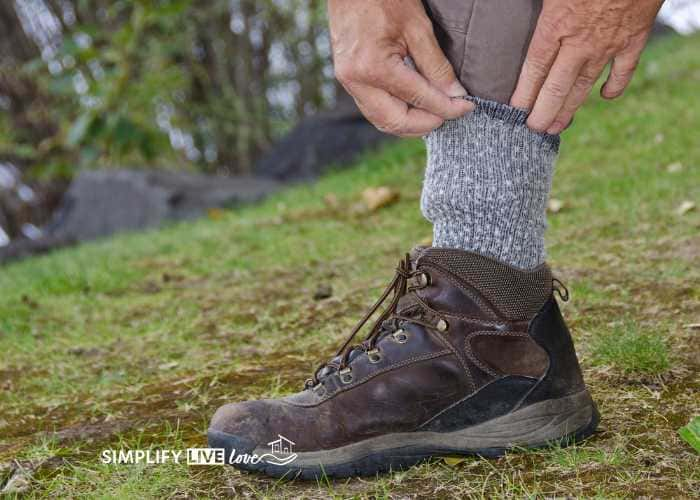How to Avoid Ticks While Hiking: 10 Proven Natural Methods to Stay Safe on the Trail
on Jun 27, 2025
This post may contain affiliate links. Please read our disclosure policy.
Learning how to avoid ticks while hiking is essential for every outdoor enthusiast who wants to enjoy the great outdoors safely. This comprehensive guide reveals the best way to implement natural tick prevention methods that will keep you protected during your outdoor adventures.
Whether you’re planning day hikes or multi-day backpacking trips, understanding tick behavior and proper preventative measures can mean the difference between a memorable outdoor experience and a potentially dangerous encounter with tick-borne illnesses like Lyme disease. The most important thing to remember is that prevention is always easier than dealing with serious diseases later.

Quick Tick Prevention Guide 🥾
🦶 Tuck long pants into socks – creates physical barrier
👕 Wear long-sleeved shirt and protective clothing – easiest ways to prevent bites
🧄 Eat garlic before hiking – great way to create natural tick repellent through skin
🌿 Apply essential oils – lavender, tea tree, citrus oils work best
🔍 Perform thorough tick checks – every 2-3 hours while hiking
🚿 Shower within 1 hour – removes unattached ticks
🌱 Use neem oil – powerful natural tick deterrent
🏠 Maintain your yard – keep grass short, remove leaf piles
🔥 Dry clothes on high heat – kills any hitchhiking ticks
⏰ Stay vigilant during tick season – prevention is the best thing you can do
To learn how to safely remove ticks you may find, read this article: What to Do If You Are Bitten by a Tick (+ When to Worry)
Medical disclaimer: I’m not a doctor, nor do I want to be. Consult your doctor for any specific concerns you may have about ticks and tick bites.
Table of Contents
- Quick Tick Prevention Guide 🥾
- Understand Where Ticks Live Before Hiking
- How to Avoid Ticks While Hiking: Clothing and Physical Barriers
- Pre-Hike Preparation: Start Tick Prevention at Home
- Natural Tick Repellents: How to Avoid Ticks While Hiking Naturally
- How to Avoid Ticks While Hiking: On-Trail Strategies
- Post-Hike Tick Prevention: How to Avoid Ticks While Hiking Complications
- Advanced Tick Prevention for Serious Hikers
- Family Hiking: How to Avoid Ticks While Hiking with Children and Pets
- Related Posts You May Like
Understand Where Ticks Live Before Hiking
Before learning how to avoid ticks while hiking, it’s crucial to understand where they live. Sadly, ticks are in all 50 states now. They’re part of the arachnid family with over 800 species worldwide. The most common hiking encounters involve deer ticks and blacklegged ticks, some as small as a grain of pepper.
Ticks prefer specific environments that hikers frequently encounter:
Prime tick habitat includes:
- Dense forests and wooded areas where ticks quest for hosts
- Tall grasses, high grass, and grassy areas in meadows
- Shrubland and brushy areas with dense vegetation
- Leaf litter on forest floors – the perfect hiding spot
- Areas with high humidity during warm weather
- Trail edges where vegetation meets paths – prime tick territory
Tick activity peaks during early summer months, though in warmer climates, tick season can extend year-round. Research from the University of Rhode Island shows that certain areas consistently have higher tick populations, making it essential to know the best place to take preventative measures before entering these zones.

How to Avoid Ticks While Hiking: Clothing and Physical Barriers
Choose the Right Protective Clothing for Tick Prevention
Your clothing choices provide an extra layer of protection and represent one of the best things you can do when learning how to avoid ticks while hiking. Proper protective clothing creates physical barriers that prevent ticks from reaching your skin.
Essential clothing tips:
- Wear long-sleeved shirt and long pants to minimize exposed skin
- Choose light-colored clothing to easily spot dark ticks crawling
- Tuck your pant legs into your socks or boots – a good idea that many overlook
- Opt for smooth fabrics over textured ones that ticks can grab
- Consider permethrin-treated clothing for extra protection
- Add a head covering to protect your scalp, especially important for those with long hair
While tucking pant legs into socks might look unusual, this simple technique significantly reduces tick access to your legs and is the only way to create a complete barrier around your lower extremities.

Pre-Hike Preparation: Start Tick Prevention at Home
Learning how to avoid ticks while hiking begins before you hit the trail. Your home environment is also important for overall tick prevention. Last year’s tick activity data shows that residential areas can harbor significant tick populations.
Yard maintenance for tick control:
- Discourage wildlife that carry ticks (deer, mice, rabbits) – these animals support adult females during reproduction
- Keep lawns mowed short and long grass trimmed regularly
- Remove leaf litter piles and debris where ticks hide in dark places
- Relocate compost piles away from high-traffic areas
- Create barriers between wooded areas and recreational spaces

Natural Tick Repellents: How to Avoid Ticks While Hiking Naturally
Garlic: Nature’s Tick Deterrent
Garlic serves as an excellent natural method for how to avoid ticks while hiking. When consumed, garlic compounds are secreted through sweat and urine, creating a natural tick-repelling aura around your body.
Ways to use garlic for tick prevention:
- Eat 2-3 raw garlic cloves before hiking
- Include garlic-rich meals in your pre-hike diet
- Take garlic supplements if you prefer
- Pack garlic-infused snacks for longer hikes
You can eat a couple cloves of raw garlic before heading out, eat food with garlic as an ingredient, or take garlic pills.
Most effective natural tick repellents using essential oils:
Mix essential oils with a carrier oil such as coconut oil or sweet almond oil and rub it on your skin, paying attention to cover areas such as ankles, scalp, behind ears and in warm areas of the body so the smell radiates off you. Like garlic, scents such as citrus, lavender, tea tree, rosemary, and cinnamon repel ticks. Do not use cinnamon on young children, however.
- Lavender oil – pleasant scent, powerful repellent
- Tea tree oil – antimicrobial and tick-repelling properties
- Citrus oils (lemon, orange) – strong tick deterrent, similar to oil of lemon eucalyptus
- Rosemary oil – effective and long-lasting
- Peppermint oil – cooling and repelling
Application method: Mix 10-15 drops of essential oil with 2 tablespoons of carrier oil (coconut or sweet almond oil). Apply to exposed skin, focusing on ankles, wrists, neck, and behind ears. This great way to repel ticks naturally works best when combined with other preventative measures.

Neem Oil: Powerful Natural Tick Prevention
Neem oil, derived from the Indian neem tree, offers exceptional tick-repelling properties. This natural pesticide ingredient provides long-lasting protection and is a key component in learning how to avoid ticks while hiking naturally.
Using neem oil safely:
- Always dilute with carrier oil (1:10 ratio)
- Apply to skin and scalp before hiking
- Add a few drops to shampoo for scalp protection
- Reapply every 2-3 hours during long hikes
You can buy organic neem oil pesticides at garden supply stores (but use that in your garden and not on your skin) or buy pure neem oil online for avoiding ticks naturally. Just use it with a carrier oil and apply to your skin and scalp as it has to be diluted or it can be irritating to skin. You can add a couple drops of it to your shampoo as well and wash with it.
Pin this now to find it later
Pin ItHow to Avoid Ticks While Hiking: On-Trail Strategies
Stick to Trail Centers
When hiking, your path choices significantly impact tick exposure. Understanding how to avoid ticks while hiking includes strategic trail navigation.
Trail positioning tips:
- Walk in the center of established trails
- Avoid brushing against vegetation and tall grass
- Choose well-maintained trails over overgrown paths
- Be extra cautious in transitional areas between habitats
Regular Thorough Tick Checks During Outdoor Adventures
Performing regular thorough tick checks is essential when learning how to avoid ticks while hiking. Early detection prevents tick attachment and disease transmission – the perfect time to catch these little pests before they can cause harm.
Tick check frequency and technique:
- Check every 2-3 hours during day hikes
- Focus on common attachment sites: ankles, waistline, armpits, scalp
- Use a hiking buddy system for hard-to-see areas and full body check assistance
- Pay close attention to warm, moist body areas where ticks prefer to attach
- Remember that adult ticks and nymphs may be extremely small and difficult to spot
Shower within 1 hour of coming inside for the day. Follow these steps to safely remove a tick if you happen to find one even after you’ve followed all the prevention steps.
Post-Hike Tick Prevention: How to Avoid Ticks While Hiking Complications
Immediate Post-Hike Protocol
Your tick prevention efforts shouldn’t end when the hike does. Proper post-hike procedures complete your strategy for how to avoid ticks while hiking.
Essential post-hike steps:
- Shower within one hour – removes unattached ticks
- Perform thorough full-body tick check – use mirrors for complete coverage
- Wash hiking clothes immediately in hot water
- Dry clothes on high heat for 10 minutes minimum
- Check gear and backpacks for hitchhiking ticks
What to Do If You Find a Tick
Despite your best efforts to avoid ticks while hiking, you may occasionally find an attached tick. Proper removal technique is crucial for preventing disease transmission and avoiding complications. Never use petroleum jelly, heat, or other folk remedies that can cause the tick to regurgitate disease-causing bacteria.
Safe tick removal process:
- Use a pair of tweezers or tick removal tool to grasp the tick close to skin
- Pull steadily upward without twisting or crushing the tick’s mouthparts
- Clean the bite area with rubbing alcohol or antiseptic
- Monitor the site for signs of infection, rash, or lyme disease symptoms
- Seek medical attention and medical advice if body aches, fever, or rash develop
- Consider taking a deep breath – not all ticks carry diseases, and prompt removal reduces risk significantly
Advanced Tick Prevention for Serious Hikers
Chemical-Free Environmental Modifications
For frequent hikers wondering how to avoid ticks while hiking long-term, consider these advanced strategies:
Habitat modification techniques:
- Create tick-free zones around trailheads
- Use beneficial insects that prey on ticks
- Implement integrated pest management approaches
- Support local tick surveillance programs
Technology and Tools for Tick Prevention
Modern technology offers additional methods for how to avoid ticks while hiking:
Helpful tools and apps:
- Tick identification apps for quick species recognition – Check out the University of Rhode Island’s Field Guide to Ticks
- Weather apps to track tick activity conditions
- GPS apps to mark high-tick areas on trails
- Timer apps for regular tick check reminders
Family Hiking: How to Avoid Ticks While Hiking with Children and Pets
Protecting Children on Hiking Adventures
When hiking with children, standard tick prevention methods may need modification. Understanding how to avoid ticks while hiking with kids requires extra vigilance and child-safe approaches, as children are more susceptible to tick-borne diseases.
Child-specific tick prevention:
- Use DEET-free insect repellent on young children
- Avoid cinnamon oil on children under 2 years
- Teach children to stay on trail centers and avoid long grass
- Make thorough tick checks fun with games and rewards
- Pack extra clothes for mid-hike changes if needed
- Pay special attention to symptoms of lyme disease in children, as they may not communicate discomfort clearly
Pet Protection During Hiking
Pets face unique tick exposure risks during hikes. Incorporating pet protection into how to avoid ticks while hiking ensures the whole family stays safe.
Pet tick prevention strategies:
- Use veterinarian-approved tick preventatives
- Check pets every 30 minutes during hikes
- Keep pets on leashes to control their movement
- Consider protective pet clothing for high-tick areas
- Brush pets thoroughly before car travel

Related Posts You May Like
The Ultimate Tick Check Routine: Protect Your Family and Furbabies














It’s totally gross, but I find a tick on myself at least once a year, usually not attached. The dogs get ticks more than that…These ARE REALLY GREAT TIPS, since the only remedy is actually a preventative for the effects of a bad tick bite 🙁
we live on the lake and in the summer find ticks often climbing on us and occasionally biting us. Tea Tree oil seems to work the best. I have learned that while they are gross there is no need to panic. This info is great advice. Since the ticks are tough little buggers I find a finger nail clipper to do great in disposing of them at the bathroom sink where I can wash down the 2 halves of the tick down the drain.